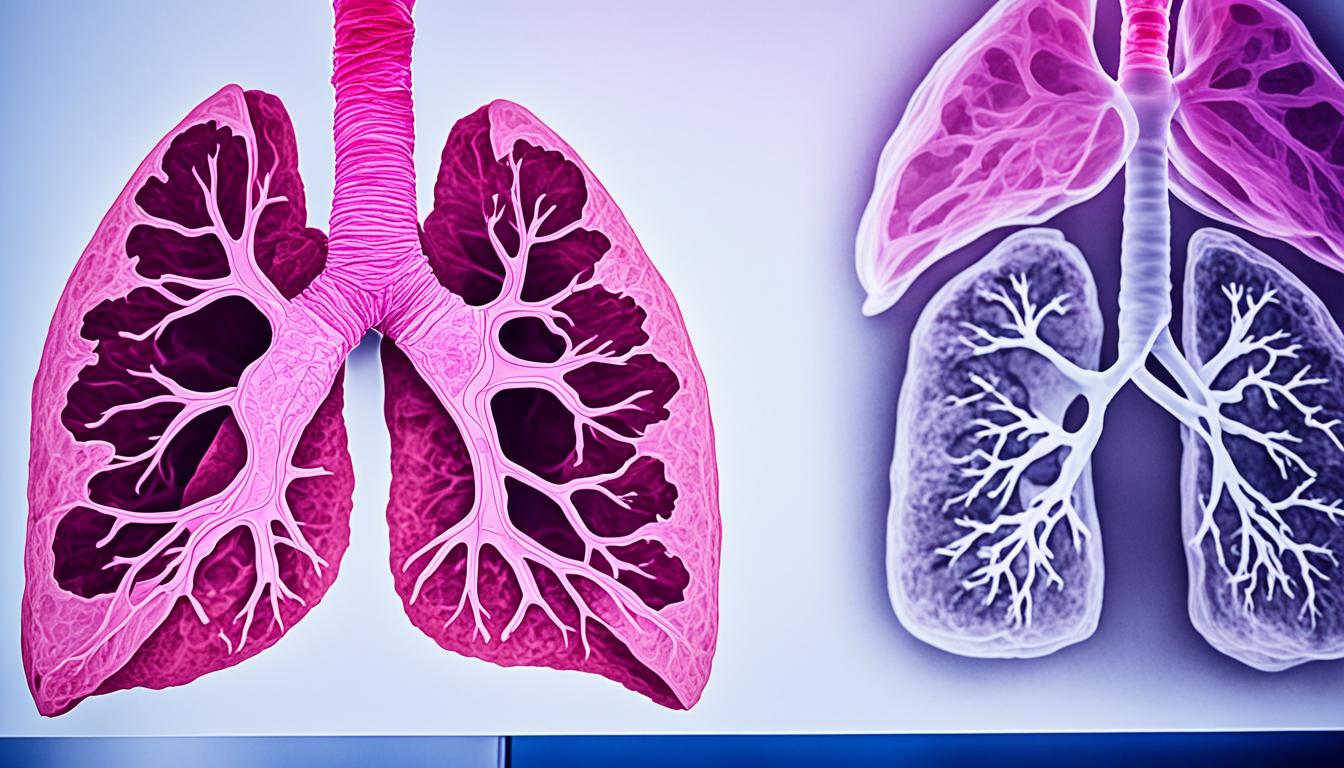Pulmonary fibrosis is a chronic lung disease that leads to lung tissue thickening and scarring. It affects people’s lives greatly. Its top form, idiopathic pulmonary fibrosis (IPF), comes without a known cause. Yet, several risk factors and triggers can bring it on.
If you smoke, you’re at a higher risk for pulmonary fibrosis. The bad stuff in cigarettes can hurt your lungs, leading to scarring. It’s not just smoking, genetic factors can also make the lungs more prone to damage. Asbestos, silica, and chemical exposure play a part too.
Viruses like the flu can spark swelling in the lungs, possibly leading to this disease. Autoimmune diseases can also up the risk. This happens when the immune system wrongly attacks the lungs.
Spotting pulmonary fibrosis can be hard since its signs are like other lung issues. Look out for breath shortness, a dry cough, feeling tired, and chest pain. To diagnose it, doctors rely on your medical history, a check-up, lung tests, and X-rays.
As of now, there’s no cure for this disease. But, there are ways to slow it down and manage its symptoms. Medicines like corticosteroids can lower swelling and help with symptoms. In tough cases, doctors might recommend lung rehab, oxygen therapy, or even a transplant.
Stem cell therapy could be a game-changer for pulmonary fibrosis. Mesenchymal stem cells (MSCs) show a lot of promise. They can become different types of cells and heal with their anti-swelling and immune-balancing effects.
- Pulmonary fibrosis is a chronic and progressive lung disease characterized by the thickening and scarring of lung tissue.
- The exact cause of idiopathic pulmonary fibrosis (IPF) is unknown, but there are several risk factors and triggers.
- Cigarette smoking, genetic factors, exposure to toxins and pollutants, viral infections, and autoimmune diseases contribute to the development of pulmonary fibrosis.
- Diagnosis involves medical history review, physical examination, lung function tests, and imaging studies.
- Treatment options aim to manage symptoms and slow down disease progression.
- Stem cell therapy, particularly with mesenchymal stem cells, shows potential in regenerating lung tissue and reducing fibrosis.
Stem Cell Therapy for Pulmonary Fibrosis
Stem cell therapy shows promise for those with pulmonary fibrosis. Mesenchymal stem cells (MSCs) are a type that stands out. They can help repair lung tissue and ease fibrosis symptoms. This offers new hope for those who cannot rely on traditional treatments.
MSCs are special because they can become different types of cells, including lung cells. This helps in repairing the lung. They also release substances that reduce inflammation. This makes the area around damaged tissue better for healing.
Stem cell therapy for pulmonary fibrosis is an area with a lot of ongoing research. The main focus is to stop the disease from getting worse. Researchers want to improve lung functions and make life better for those living with this condition.
Pulmonary Fibrosis Prognosis and Support Groups
Knowing about the future of pulmonary fibrosis is important. The disease always gets worse over time. But how fast it gets worse can vary. This depends on the person’s health, age, and how they respond to treatment.
Support groups are very helpful for both patients and their families. They offer a way for people to share their stories and support one another. This includes learning about treatments and the newest research. Joining these groups can really help improve mental health while living with the condition.
| Pulmonary Fibrosis Research | Pulmonary Fibrosis Lung Transplant |
|---|---|
| Research is looking into the cause of the disease and ways to treat it better. It includes new techniques like gene therapy and better imaging. The goal is to find more ways to help patients and improve their care. | When the disease is very serious and other treatments are not working, a lung transplant might be an option. Not everyone can get a new lung. There are many tests and considerations that need to happen before a transplant. But for those who do get one, it can bring a new life. |
Using stem cell therapy in treating pulmonary fibrosis offers hope for better outcomes. It’s important to keep up with research and connect with support groups. A personal treatment plan is crucial. This approach helps in dealing with the challenges of the disease.
Conclusion
Pulmonary fibrosis is a serious lung disease. It makes lung tissue thick and scarred. Its main cause is unknown, but some things can make it worse. These include smoking and certain jobs. We need more research to find its true causes and better treatments.
Treating pulmonary fibrosis now is hard. Steroids can help with symptoms but not cure it. For some, getting a new lung through transplant might be the answer. Yet, this isn’t an option for everyone. The lack of donor organs and transplant risks limit who can benefit.
Stem cell therapy offers a new ray of hope. It can help grow new lung tissue and change how the immune system reacts. This might provide a more direct way to fight the disease. Scientists are working hard to see if this therapy can really help. They hope to make life better for those with pulmonary fibrosis.
In summary, living with pulmonary fibrosis is tough. But, research and new treatments give us hope for the future. The medical field is dedicated to finding better ways to help. This focus aims to offer improved care and life-quality for people facing this challenge.

